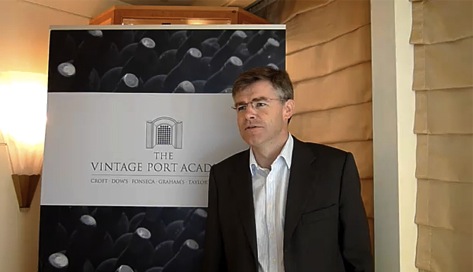During the cold winter months, Port is a great wine to warm you up. While it is traditionally enjoyed after a meal, we at Asian Palate suggest it as drink on its own between meals. Port was created by the British merchants nearly 300 years ago mainly to ensure the strong wine fortified with grape brandy would survive the long seafaring journey. Along with the former British colonial influence and Macau’s proximity, Port remains a popular drink with a niche group of residents in Hong Kong.
At the end of last year, The Vintage Port Academy visited Hong Kong and hosted its 4th series of workshops on “The Essential Knowledge of Port”. The Vintage Port Academy was founded in 2010 by Euan Mackay (Sales Director of Symington Family Estates) and Nicolas Heath (Marketing Director of The Fladgate Partnership). Since its establishment, the academy has awarded over 380 members of the trade the ‘Vintage Port Academy Certificate’ and pin. Both Mackay and Heath were present at the workshop in Hong Kong and introduced the highly acclaimed 2011 vintage ports to the Hong Kong wine and lifestyle media. 2011 represents the third generally declared vintage since 2000. We had a chance to speak with Mackay about vintage port.
AP: Asian Palate EM: Euan Mackay
AP: What are the latest trends in vintage port? Are Port houses trying to make them easier to drink earlier rather than opting for long aging in bottle?
EM : Vintage port remains our most precious wine, only released when the quality is judged by ourselves to be of the highest quality and have the capacity to age in bottle for at least 25-30 years. We continue to make these wines with the utmost care and attention, drawing grapes from our extensive vineyards in the Douro. Today, Symington is by far the largest landowner in the region with close to 1000 hectares of top quality vineyards. It is the sheer quality of the grapes that are grown on these vineyards that allows these complex and structured wines to be enjoyed when young as well as old.
AP: Which markets in Asia are the biggest markets for Port and which show most potential?
EM: Hong Kong and Singapore remain important markets in Asia for port, although we are now seeing encouraging signs in Mainland China, Taiwan, South Korea and Indonesia.
AP: How is Port enjoyed in Portugal? With a meal, before or after? Is this changing?
EM: The United Kingdom remains the most important premium port market today where port is drunk mainly after the meal and principally at Christmas time. In other markets including Portugal, there is a growing interest in matching port with dark chocolate and other desserts including cheese.
AP:What food/dishes both European and Asian do you think pairs well with vintage Port?
EM: The classic combination in Europe is vintage port and blue cheese or simply on its own. In Asia we are learning and have found some interesting matches with rich meat dishes such as Wagyu beef, Kurobuta pork with bean sprout soya sauce or sweet and sour spare ribs.
AP: In vintage Port making, how important is the maceration technique, such as foot trodding, in contributing to quality? What are the other winemaking factors that most affect quality?
EM: Working the grapes prior to the fermentation either using the traditional foot treading technique or a modern stainless steel version remains a critical element in the making of top quality port. It is not so much a maceration technique but one where the grapes are trodden for at least 4 hours before the fermentation in order to extract as much of the color and flavors from the grapes as possible. This is particularly important given that we only have a small window (between 36-48 hours) to ferment before the fortification. Failure to tread the grapes beforehand could lead to a lack of extraction thus producing wines that do not have the structure and concentration needed for long ageing. Other factors include selection of the grapes in the vineyard, good temperature control, keeping the skins in contact with the must during fermentation and the use of top quality neutral grape spirit.










